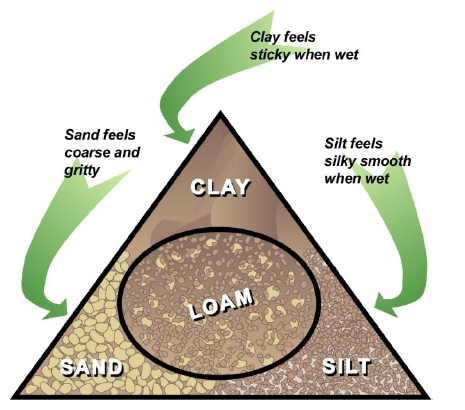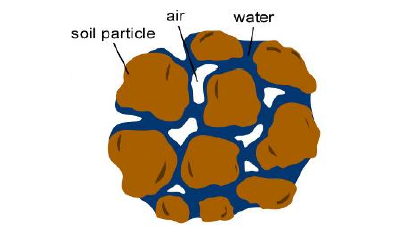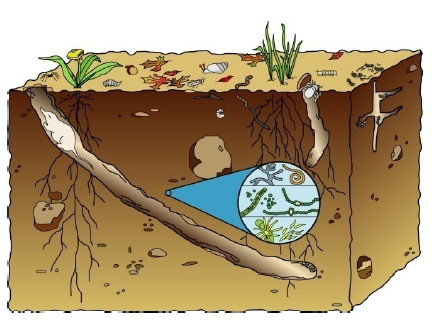Introduction
Often, gardeners focus on the plants in their landscape. However, successful plants rely on healthy soils to support them. In northern Nevada, soils are extremely variable and can provide challenges for the gardener. Learning more about soil will help you develop a beautiful and productive garden or landscape.
Soil texture and porosity
Soil texture refers to the relative proportions of sand, silt and clay particles in the soil. Sand grains are the largest particles (0.05 to 2 millimeters (mm) in diameter), silt grains are intermediate in size (0.002 to 0.05 mm), and clay grains are the smallest (less than 0.002 mm). An ideal gardening soil, called a loam, is a balanced mixture of sand, silt and clay particles.
In a typical soil, there will be about 50 percent to 60 percent solid material and 40 percent to 50 percent pore space, or gaps between the particles. In an ideal soil, about half of the pore space is filled with water and half with air. Pore space is essential for plant growth, providing space for plant roots to grow. Soil pore space also provides a home for living organisms.
Soil texture affects the porosity and permeability of the soil. Porosity refers to the amount of pore space in a soil and permeability is how quickly water moves through the soil. Permeability is determined by how well‐connected the pore spaces are to one another. These two factors affect infiltration rates, or how quickly water moves into the soil, and water‐holding capacity, or the ability of soil to hold water. This held water is stored in the soil and can be used by plants. In general, the higher the percentage of silt‐ and clay‐sized particles, the higher the water‐holding capacity and the slower the infiltration rate of the soil. A productive soil allows water to infiltrate and also holds the water for plant use.

Loam is a combination of sand, clay, and silt. The image is by NRCS, Bozeman, Montana.
higher the percentage of silt‐ and clay‐sized particles, the higher the water‐holding capacity and the slower the infiltration rate of the soil. A productive soil allows water to infiltrate and also holds the water for plant use.
In urban and agricultural settings, soil often becomes compacted by foot traffic, mechanical equipment, and other factors. When the soil is compacted or loses pore space, it is harder for water to infiltrate and the soil has less waterholding capacity. Compacted soil has less pore space in which plants and other living organisms can grow and thrive.

An ideal soil
Tips for avoiding compaction
- Limit foot traffic on wet soil.
- Avoid heavy equipment traffic on soil, especially when it is wet.
- Limit foot traffic and vehicle traffic to specific paths and zones.
- Limit vegetation removal to reduce the potential for soil compaction and erosion.
Organic matter
Organic matter helps increase the ability of a soil to absorb and store water. In a productive agricultural soil, organic matter content may range up to 5 percent. In Nevada, the organic matter content of native soil tends to be very small, often less than 1 percent.
Adding organic material improves many northern Nevada soils. In porous, sandy soils, the addition of organic matter slows water movement through the soil, increasing the soil’s water‐holding capacity. In clay‐rich soils, the addition of organic matter helps loosen the soil, improving or increasing water infiltration and drainage. Organic material also acts as a holding station for plant nutrients, keeping the nutrients in the soil where they are needed by plants. It further reduces the potential for nutrient pollution to groundwater and surface water.
Organic material soil amendments come in many forms. Give careful thought to what kind of organic matter to add to your soil. Composted organic material is the best. Composting reduces the volume of the organic material and breaks down the organic components into simpler nutrient forms that are more available to plants. Uncomposted materials actually use plant nutrients during their breakdown in soil, robbing plants of these nutrients. Composting also generally decreases many potential problems, such as diseases, insect eggs and larva, and weed seeds.
Some uncomposted materials, such as manure, may add or transfer diseases, such as E. coli and viruses, and weed seeds that pass through the animals. Depending on the species of animal, adding uncomposted manure also may damage your plants or seeds due to high levels of nitrogen and salts. Poultry, horse and cow manure will often damage or “burn” plants if it is not composted or well‐rotted.
Soil biology
Healthy soils are full of living creatures, such as earthworms, insects, mites and other arthropods, nematodes, and microscopic plants and animals including bacteria and fungi. Together, these living creatures are called soil biota. The population of soil biota is directly related to the amount of organic material in the soil.
Soil biota play an important role in infiltration, water‐holding capacity, pollutant processing, nutrient retention, nutrient cycling and plant growth. Soil biota transform and cycle carbon, nitrogen and other mineral nutrients in plant and animal residues into forms that can be used by plants. Soil bacteria have a wide range of abilities to break down pollutants into less harmful components, purifying water as it moves through the soil.
Low soil organic matter content reduces the biological component of the soil. Compaction reduces pore space, reducing the habitat available for soil biota. As the number of living organisms in the soil decreases, soil fertility also decreases, limiting plant growth.

Assessing your soil
An on‐site inspection of your soil can tell you a lot. How does your soil feel? Sandy soils feel gritty, clay‐rich soils are very sticky and silty soils are smooth. Is your soil a dark, rich brown color or a pale light brown color? In general, the greater the organic matter content, the darker the soil color.
How does your soil smell? If it smells like rotting vegetation, the soil drainage is not good. How well does your soil drain? Clay‐rich soils have very slow infiltration rates, but so do compacted soils. Soil drainage is a function of soil texture, porosity and permeability. In general, sandy soils will drain faster than clay soils.
Drainage can also be affected by shallow soil depths and high water tables. Another factor that can affect soil drainage is the presence of soil interfaces (see below). For more information on soil quality assessment, refer to Assessing Soil Quality, University of Nevada Cooperative Extension Fact Sheet‐09‐17.
Soil chemical composition
Unfortunately, a visual inspection will not tell you much about the chemical composition of your soil. To determine this, you must have your soil tested. Soil testing provides information on the texture and chemistry of the soil. Soil chemistry involves factors like pH, electrical conductivity (EC) and the chemical components of the soil necessary for plant growth, known as plant nutrients. When we add fertilizer or amendments to the soil, we are trying to increase these chemical components or change them into a form more available to plants.
Soil pH
A measure of the acidity or alkalinity of your soil. A pH value of less than 7 is considered acidic, a pH value of greater than 7 is considered alkaline or basic and a pH of 7 is termed neutral. Why is this important? The pH of a soil affects the availability of nutrients to plants. Some plant nutrients, such as iron, are very sensitive to pH and may become unavailable for plant uptake at certain pH ranges. Soil pH can also limit the types of plants that will grow in a soil. Many plants require an acidic or alkaline soil for growth. In northern Nevada, most of our soils are alkaline, with pH values greater than 7. A soil test will help you pick the right plants for your landscape and soil.
Electrical conductivity, or EC
A measure of the soluble salts in a soil. Soils high in soluble salts can damage or kill some plants. If the EC value is high, indicating a salty soil, your plant choices are limited. Knowing this before you buy plants can save you time, money and frustration.
Plant nutrients
Are elements necessary for plant growth. They are commonly subdivided into macronutrients (required in significant amounts) and micronutrients (required in small amounts). A chemical analysis of soil should include an analysis for macronutrients, including nitrogen, phosphorus and potassium. It may also measure three additional macronutrients: sulfur, calcium and magnesium. Micronutrients (iron, manganese, zinc, boron, molybdenum, nickel, copper, cobalt and chlorine) must usually be requested for an additional fee. The presence of these micronutrients in small concentrations is necessary for plant growth. If you live in an area where a deficiency or an abundance of any of the minor nutrients is a problem, you may wish to have them measured.
Too little or too much of any nutrient can harm plant growth. Use the results of a soil test to ensure you add only the nutrients your soil needs, providing a productive landscape with minimal wasted time and money. Additionally, you may choose to test for any elements that can cause potential harm and may be common in your area, such as arsenic or selenium. Most soil labs provide a recommendation for adding fertilizer, generally in terms of pounds of fertilizer per acre or square feet of land.
Your results will only be as good as the sample you take. To learn to take a soil sample properly, refer to How to Take a Soil Sample, University of Nevada Cooperative Extension Fact Sheet‐09‐13. Each soil testing lab will have its own requirements for sample size, handling and packaging. Contact the lab before collecting the sample. Check with your local Cooperative Extension office for a list of soil testing labs in your area.
How to Avoid Interfacing
In many instances, the upper layer of a soil may become completely saturated with water before the water moves below the surface layer. This phenomenon is called interfacing. An interface forms when soils of different textures are placed next to one another or layered with one another. Many gardeners inadvertently create interfaces when they add organic material or topsoil to a garden plot and fail to work it in, or when they backfill a shrub‐ or tree‐planting hole with organic material instead of native soil. The addition of organic material will improve the soil, provided you work it into the native soil, rather than laying it on the top.
Tips to help you get to know your soil:
- Walk your property and look to see where plants are growing well, and where they are not.
- Determine your soil’s texture. Soil texture affects porosity and permeability. Porosity and permeability affect water infiltration and soil drainage.
- Locate areas of soil compaction and determine how they became compacted. Look for the presence of standing or ponded water after irrigation or areas with little or no plant growth. Develop a plan to reduce compaction in the future by limiting or avoiding foot or vehicle traffic, especially when soil is wet. Reducing compaction and increasing the pore space available for water and air allows soil biota to flourish. This also improves the productivity of your soil.
- Many Nevada soils are low in organic matter. Increasing the organic matter content of a soil increases the water‐ and nutrient‐holding capacity, improves the porosity and permeability, and increases the likelihood of adequate soil biota. Use composted organic material to limit the introduction of insects, weeds and diseases into the soil.
- Soil biota is the living portion of your soil, the earthworms, insects and microscopic plants and animals that contribute to soil productivity and fertility. Does your soil appear to have plentiful biota? Maintaining or improving the porosity and organic‐matter content of the soil helps to provide a good home for soil organisms.
- Have your soil tested to determine its chemical properties. The results will help you choose appropriate plants for your landscape. A soil test will identify the nutrients lacking in the soil. By only applying those nutrients that are deficient, you will save both time and money.
References
Donaldson, S, et al, 2008, Living on the Land: Stewardship for Small Acreages, Module 2: Your Living Soil, University of Nevada Cooperative Extension CM‐08‐ 07, Reno, Nevada.
Scheyer, J.M. and K.W. Hipple, 2005, Urban Soil Primer, United States Department of Agriculture, Natural Resources Conservation Service, National Soil Survey Center, Lincoln, Nebraska. NRCS
Hefner, M., Skelly, J., and Donaldson, S.
2009,
Nevada’s Soils – Worth the Toil,
Extension | University of Nevada, Reno, FS-09-14


